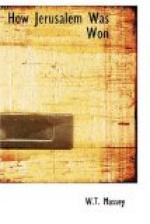The river Auja is a perennial stream emptying itself into the blue Mediterranean waters four miles north of Jaffa. Its average width is forty yards and its depth ten feet, with a current running at about three miles an hour. Till we crossed it the river was the boundary between the British and Turkish armies in this sector, and all the advantage of observation was on the northern bank. From it the town of Jaffa and its port were in danger, and the main road between Jaffa and Ramleh was observed and under fire. The village of Sheikh Muannis, about two miles inland, stood on a high mound commanding the ground south of the river, and from Hadrah you could keep the river in sight in its whole winding course to the sea. All this high ground concealed an entrenched enemy; on the southern side of the river the Turks were on Bald Hill, and held a line of trenches covering the Jewish colony of Mulebbis and Fejja. A bridge and a mill dam having been destroyed during winter the only means of crossing was by a ford three feet deep at the mouth, an uncertain passage because the sand bar over which one could walk shifted after heavy rain when the stream was swollen with flood water. Reconnaissances at the river mouth were carried out with great daring. As I said, all the southern approaches to the river were commanded by the Turks on the northern bank, who were always alert, and the movement of one man in the Auja valley was generally the signal for artillery activity. So often did the Turkish gunners salute the appearance of a single British soldier that the Scots talked of the enemy ‘sniping’ with guns. To reconnoitre the enemy’s positions by daylight was hazardous work, and the Scots had to obtain their first-hand knowledge of the river and the approaches to it in the dark hours.




